Do you have a question about the Carrier ComfortLink 30HXA and is the answer not in the manual?
General safety advice for installation, servicing, and handling equipment.
Warnings about electrical shock hazards and the need to shut off power.
Vent all relief valves outdoors and handle refrigerant vapors.
Receives inputs for temperature reset, cooling set point, and demand limit.
Immediately shuts down the chiller by cutting power to modules.
Controls refrigerant flow via a stepper motor for precise cooler level control.
Details how the EXV operates to control refrigerant flow based on superheat.
Explains economizer function for capacity improvement and motor cooling.
Describes the operation and function of the prelubricating oil pumps.
Gathers information from sensors for chiller operation control.
Monitors compressor status, motor temp, high-pressure, and controls solenoids.
Explains the two methods for starting compressors and their benefits.
How the system cycles components to maintain the leaving fluid temperature set point.
Modifies the normal operation of the capacity control routine.
Prevents unit capacity increase if saturated suction temperature is too low.
Microprocessor controls condenser fans to maintain saturated condensing temperature.
Fan staging based on compressor status or saturated condensing temperature.
Controls direct acting water valves based on PID loop for head pressure.
Fans controlled by relay outputs or variable speed for head pressure control.
Function to verify proper operation of outputs, compressors, and other components.
Testing of EXV, variable head pressure, oil pump, motor cooling, and fans.
Testing of compressor relays, loaders, minimum load valve, and oil heater.
How to view active alarms, alarm history, and clear alarms.
Explanation of 2-stage switch, 4-20mA, and CCN Loadshed demand limiting.
Configuring demand limit using a 4 to 20 mA signal.
Configuring demand limit using a CCN Loadshed module.
Detailed configuration steps for demand limit settings.
How to interpret diagnostic information displayed on the Navigator.
Procedures for shutting off the unit using the EOR switch or emergency stop.
Lists conditions that can cause a complete unit shutdown.
Lists conditions that cause a single circuit to stop without affecting the other.
Steps for restarting the unit after a stoppage, including manual reset.
Warnings of abnormal conditions that may cause shutdown or default values.
Common stoppage faults and their corresponding reset types.
Lists alarm/alert codes, description, cause, action taken, and probable cause.
Detailed explanations of various alarm and alert codes.
Specific causes and actions for alarms related to compressor protection, refrigerant flow, and dual chiller communication.
Steps for inspecting and opening electronic expansion valves.
Procedures for servicing cooler and condenser components.
How to check for low refrigerant charge using sight glass and EXV percent open.
Procedure for adding refrigerant charge to 30HXC systems.
Procedure for adding refrigerant charge to 30GX and 30HXA systems.
Procedure for adding oil charge to 30HX,GXN,GXR systems.
Step-by-step procedure for changing a compressor.
Troubleshooting steps for faulty transducers, including voltage checks and comparisons.
Description and troubleshooting of the flow sensor and its LEDs.
Safety devices and logic protecting the compressor from overcurrent and other faults.
CCP modules protect compressors from overcurrent; MTA settings are critical.
Table showing high-pressure switch settings in psig and kPa.
Shuts down chiller if leaving fluid temperature drops too low.
Description of fusible plugs and pressure relief valves.
Operation and troubleshooting of control modules (MBB, SCB, EXV, EMM, CCP, Navigator).
Connecting the chiller to a CCN for network communication.
Information on ordering and replacing defective control modules.
Recommended maintenance schedule for the chiller.
Verifying installation and wiring of all components before startup.
Procedures for actual start-up and verifying proper operation.
Describes the sequence of events during chiller startup.
Table mapping unit models to punch-out configurations and must trip amps.
Example loading sequences for 30HX chillers.
Diagram illustrating typical system components without an economizer.
Diagram illustrating typical system components with an economizer.
Diagram illustrating system components for 30HXC Circuit A with economizer.
Diagram illustrating system components for 30HXC Circuit B with economizer.
Diagram illustrating system components for 30HXC076-146 without economizer.
Diagram illustrating system components for 30HXC161-186 with economizer.
Diagram illustrating system components for 30HXA076-146 without economizer.
Diagram illustrating system components for 30HXA161-186 with economizer.
Maintenance display for service test mode controls.
Configuration for PID gains, miscellaneous settings, and compressor enable.
Configuring the Motormaster V VFD for different operating modes.
Observing system operation and VFD display information for troubleshooting.
Enabling Service Test Mode to perform component tests.


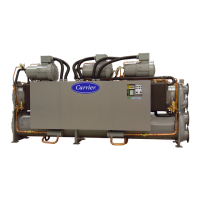

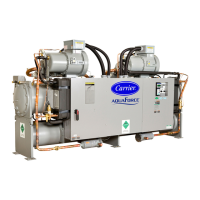
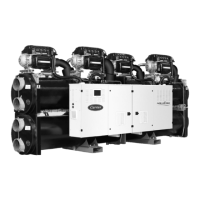

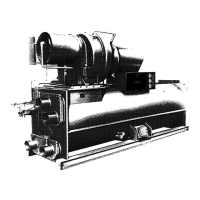
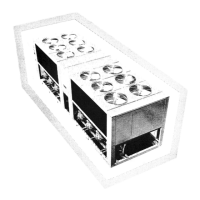

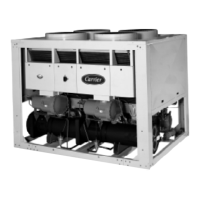

